I seem to be getting a little behind with these posts. Sorry, we’ve been a little preoccupied in the UK with an election lately. But I have managed to keep posting a picture every day to Hull Photos.
25 May 2017
Weeds have sprung up around the base of the noticeboard for Hull Docks Bye Law No 43, but the sign is still in good condition, though hardly needed as the swing bridge and lock gates are no longer in operation.
There is still water in the entrance lock, and also some in the dock beyond, though much of it was badly silted after almost 7 years of closure. On the dock side opposite are rows of caravans, newly made and waiting to be sold, and behind them, on the other side of the hidden railway tracks, industrial buildings around West Dock St, some still recognisable – I think Batty Joiners and buildings at the rear of GFG Plastics.
The railway tracks were soon to be replaced by the South Docks Road, under construction in 1984 and renamed the Clive Sullivan Way after the death of the famous Welsh rugby league star from cancer aged only 42. He played for both Hull and Hull KR and became the first black captain of any British national sporting side in 1972. His 250 tries in 12 years at Hull remains a record for the club (and there were another 118 for Hull KR.)
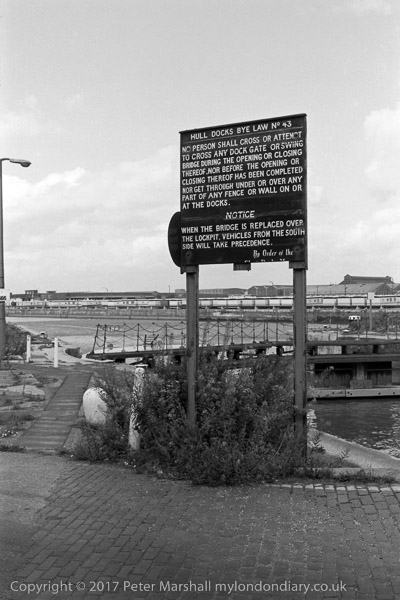
32t42: Hull Docks Bye Law No 43, St Andrew’s Dock, 1982 – Docks
26th May 2017
This notice ‘ALL CREWS TO BE DOWN BY 11AM FOR ORDERS OR SUBSTITUTES WILL BE FOUND’ was in surprisingly good condition and suggests that this office in a building on St Andrew’s Dock may still have been in use, despite the dock having closed almost 7 years earlier.
I cannot now recall exactly where this door was at St Andrews DOck, but it must have been in a fairly dark area to have forced me to use flash to record it. Although I carried a small electronic flash unit in my camera bag, it was seldom used, not least because the results were not entirely predictable – and you only found out if they had been successful when the film was developed. Later I bought an expensive flash meter which removed most of the doubt.
British United Trawlers Ltd had led to move from St Andrews Dock, to accommodate its large freezer trawlers, but the move to William Wright Dock (the western end of Albert Dock, next to St Andrew’s Dock) took place as the Cod Wars with Iceland’s 200 mile limit and further restrictions from EU entry meant there was almost nowhere for Hull’s fleet to fish. Two Hull family firms J Marr and Boyd Line survived in the later years. Boyd was taken over by the Icelandic company Eimskip in 2002 and Marr bought by Reykjavik based UK Fisheries, part of the Samherji group in 2006.
My flash technique was rudimentary in the extreme – the flash mounted on the hot shoe of the camera. This was probably taken with an Olympus OM2 which had one of the most advanced flash systems then available, the TTL OTF Auto Flash Exposure Control system which allowed the camera to meter flash, rather than relying on a photo-cell in the flash unit or, more often, a calculation using the flash guide number and the subject distance.
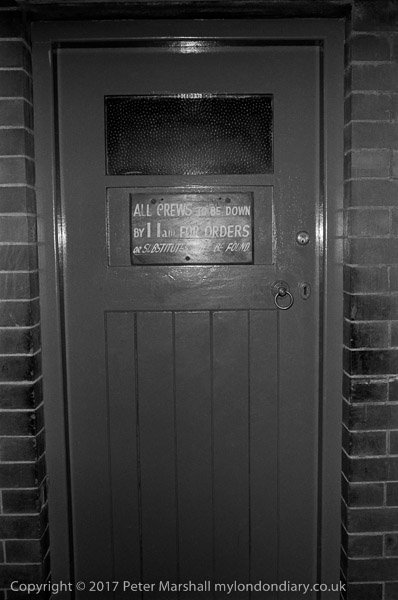
32t43: Notice to fishing crews, St Andrew’s Dock, 1982 – Docks
27th May 2017
This was the western end of those two pipes which can be seen on the opposite side of the dock entrance. In my picture they appear to descent from the heavens, but in reality they came from the first floor of the building to my left, out of site as I took the picture, then identified as ‘Industrial & Maritime Riggers Limited’ but formerly the former Boston Deep Sea Fisheries Ltd office and the Sea Fish Industry Authority.
The Bullnose was named for its shape, jutting out in to the river at the mouth of the St Andrew’s Dock entrance channel, and apparently men who had not found a place on a crew would wait there in the hope of jumping down into a trawler that was leaving shorthanded if the skipper gave them a signal they were wanted.
When I took the picture the only fishermen were those with rod and line, but it is now the site of one of several memorials to the trawlermen of Hull who sailed from here never to return. Fishing was one of Britain’s most dangerous occupations, with no safety laws once on board, casually hired crews and skippers with absolute authority. Effective trade union organisation only came to Hull after the 1968 loss with all hands of the St Romanus and the Kingston Peridot – 40 men. The TGWU set up a meeting but it was the women of Hull, led by ‘Big Lil’ Bilocca, who took effective action. The men knew that if they spoke out they would be blacklisted by the trawler skippers and owners.
Women had traditionally been kept away from the fish dock, their presence thought to bring bad luck, but Big Lil led a group of women to the dock, resolved to prevent any trawler leaving without a radio operator on board to call for help if necessary. There was a huge fight as Big Lil tried to board the St Keverne when she heard there was no radio operator on board, watched and reported by the press – and though the women failed to stop the boat, the owners sent out a radio operator to the ship as it went down the Humber.
The women’s action persuaded the men they should take action too, and a crew refused to sail because of the poor condition of their life-jackets. The loss of another trawler, the Ross Cleveland, a few days later – with only one survivor from a crew of 19 – brought matters to a head, with the women going down to see the Labour government in London with the demands of a fisherman’s charter. New safety rules were introduced as a result – saving the lives of many not just in Hull but in ports around the country.
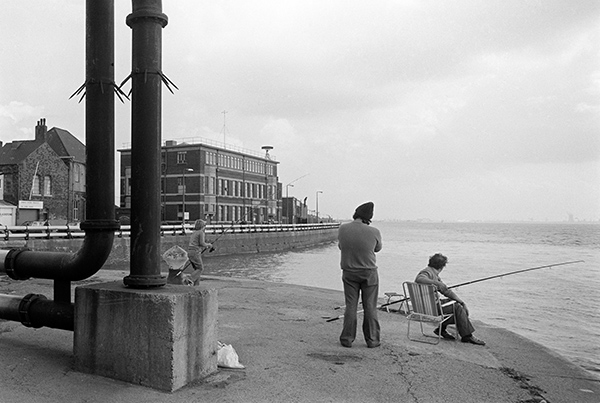
32t44: The Bullnose, St Andrew’s Dock entrance, 1982 – Docks
28th May 2017
The outer dock gate can just be seen under the pipes crossing the dock entrance, which can here be seen to go along the side of the building immediately to the west of the entrance, here named as ‘Industrial & Maritime Riggers Limited’.
The dock had at this time been out of use for almost seven years, and although there was some water beyond the lock it was severely silted up. The pipes are no longer there, but the lock is now full of mud and there is no access across the lock gates, though you can walk around where a new roadway has been laid across the dock entrance where there used to be a swing bridge.
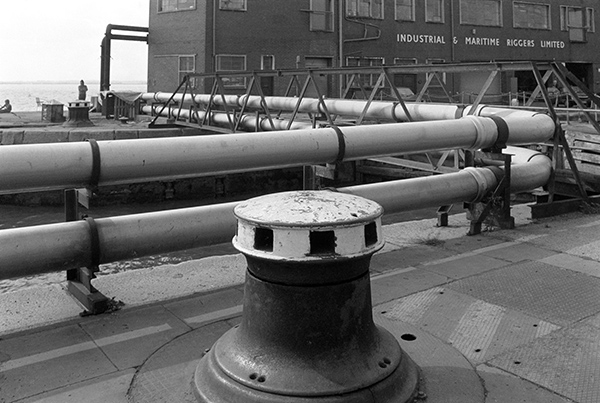
32t53: St Andrew’s Dock entrance, the Bullnose and pipes, 1982 – Docks
29 May 2017
There is still a canopy over a loading bay here, although the factory is now Maizecor rather than R & W Paul Ltd, and there is still a concrete post with the sign for Scott St, and some way down the road the postwar council housing, and that decorative fence between Wincolmlee and the now vestigial end of Scott St is still there, but the buildings in the centre of this image have disappeared, replaced by some uninspired metal sheds and yards, doubtless much cheaper to maintain and serving a useful purpose.
The building which is on the corner of Catherine St and Scott St appears to have been built as the Vulcan Iron Works (unsurprisingly a common name for iron works) for Tindall & Co, Ironfounders. Around 1900 it was owned by Messrs Tindall, Earle and Hutchinson Ltd, Marine and General Engineers who among other things made engines for steel screw ships. In 1904 the works was divided and sold; among the occupants after this was H Smith & Co, Electrical Engineers, who may have made the lamp post on the corner in my picture.
It does seem a shame that a building which surely could have been renovated and put to new use like this has been lost – but its fate is so common in Hull. Had this and the nearby Scott Street Chapel been kept, this area with its still existing buildings on Wincolmlee, the hydraulic power station in Machell St and the listed Scott St Bridge would have been an interesting area and certainly one worthy of conservation.
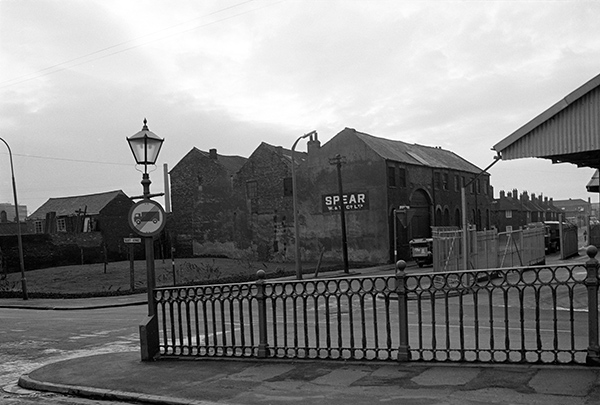
33g12: Wincolmlee and Scott St from Jenning St, 1982 – River Hull
30th May 2017
An unprepossessing 20th century industrial building probably on Wincolmlee who made electrical harnesses – bundles of cables and connectors – for various makes of cars and other vehicles. Apparently Auto-Sparks Ltd Hull dates back to an electrical business founded by Mr Henry Colomb on Beverley Rd in the 1920s. Auto-Sparks Ltd was incorporated in April 1942 and a history page on the web site of its successor company, Autosparks reproduces the original company logo from 1954 when it was registered as a trade mark.
After the original owner and manager retired in the 1980s Auto-Sparks got into difficulties and collapsed in 1991. It was bought and moved to Sandiacre in Nottingham by R D Components who were specialists in classic motorbike and car harnesses and they took over the name as Autosparks, and in 2005 became Autosparks Ltd.
This picture was taken in December, and my attention was drawn to the building by the Christmas decorations drawn on its first-floor windows. And by wondering whatever an electric harness was.
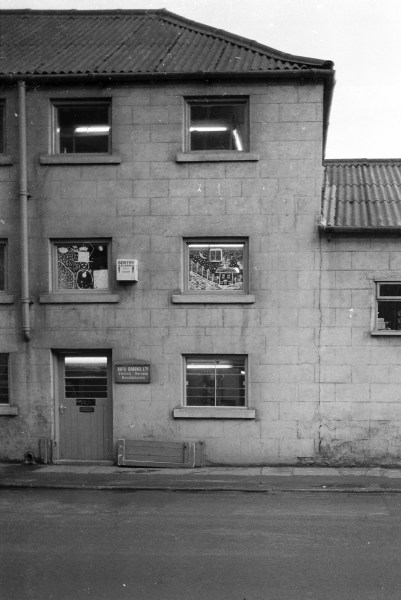
33g21 Auto-Sparks Ltd, Electric Harness Manufacturers, Wincolmlee, 1982 – River Hull
31 May 2017
One of Hull’s Grade II listed buildings, Scott St Bridge, a hydraulically-powered double bascule bridge, was opened in 1901, and was ‘temporarily closed’ in November 1996. The operating machinery has since been removed – though the official listing in 1994 says it was renewed late C20 and calls the bridge ‘complete and operable’ which suggests that it has been deliberately allowed to deteriorate by the council.
An application was made for consent for partial demolition of this bridge in 2007, apparently to save the small annual maintenance cost of the bridge in its fixed upright condition. The cost of a full refurbishment to put it back into use was estimated at £3-5m, but some feel a rather cheaper solution could be engineered to allow pedestrian and cycle use. Some Hull Council members were extremely keen for it to be demolished, but plans were abandoned as it was thought unlikely that the necessary consent would be obtained from the Government Office.
There were surprisingly few objections to its demolition, with the Environment Agency, Hull Society, the Humber Archaeology Partnership and the 20th Century Society raising no objections. A ‘historical audit’ was carried out apparently concluding “the bridge should not be kept”. Fortunately English Heritage, the Victorian Society and the Ancient Monuments Society stood firm. English Heritage because a council demolishing a listed building it owned would be a bad example and the AMS realising its “intrinsic and historical value”.
As someone who has often had to detour on my walks, I find the conclusion that “there are alternative bridges crossing in the vicinity for pedestrians and cyclists as well as vehicles” unsatisfactory. It adds around 900 metres to a journey from Scott St to St Mark St via North bridge or around 1100m via Sculcoates Bridge. Obviously this was a statement made by those who only ever travel by car.
The whole story of this bridge – and of the failure to conserve other buildings in the area – is a part of the cultural snobbism that regards industry and the monuments of industry as of little or no value. Given the tremendous importance of this country in the industrial revolution and scientific and engineering advances of the nineteenth and 20th century this is ludicrous. It’s a prejudice that English Heritage at least did a little (though not enough) to combat with its listing of structures such as this in the 1990s.
At the right of the picture is Grosvenor Mill and beyond that a ship is moored at a wharf – unfortunately the image is not sharp enough to read its name because of depth of field. All of the buildings visible on the bank beyond the mill are now demolished.
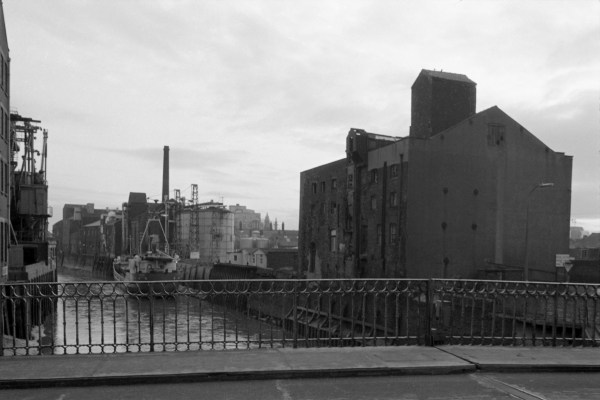
33g22: River Hull, downstream from Scott St Bridge, 1982 – River Hull
You can see the new pictures added each day at Hull Photos, and I post them with the short comments above on Facebook.
Comments and corrections to captions are welcome here or on Facebook.
______________________________________________________
There are no adverts on this site and it receives no sponsorship, and I like to keep it that way. But it does take a considerable amount of my time and thought, and if you enjoy reading it, a small donation – perhaps the cost of a beer – would be appreciated.
My London Diary : Buildings of London : River Lea/Lee Valley : London’s Industrial Heritage
All photographs on this and my other sites, unless otherwise stated, are taken by and copyright of Peter Marshall, and are available for reproduction or can be bought as prints.